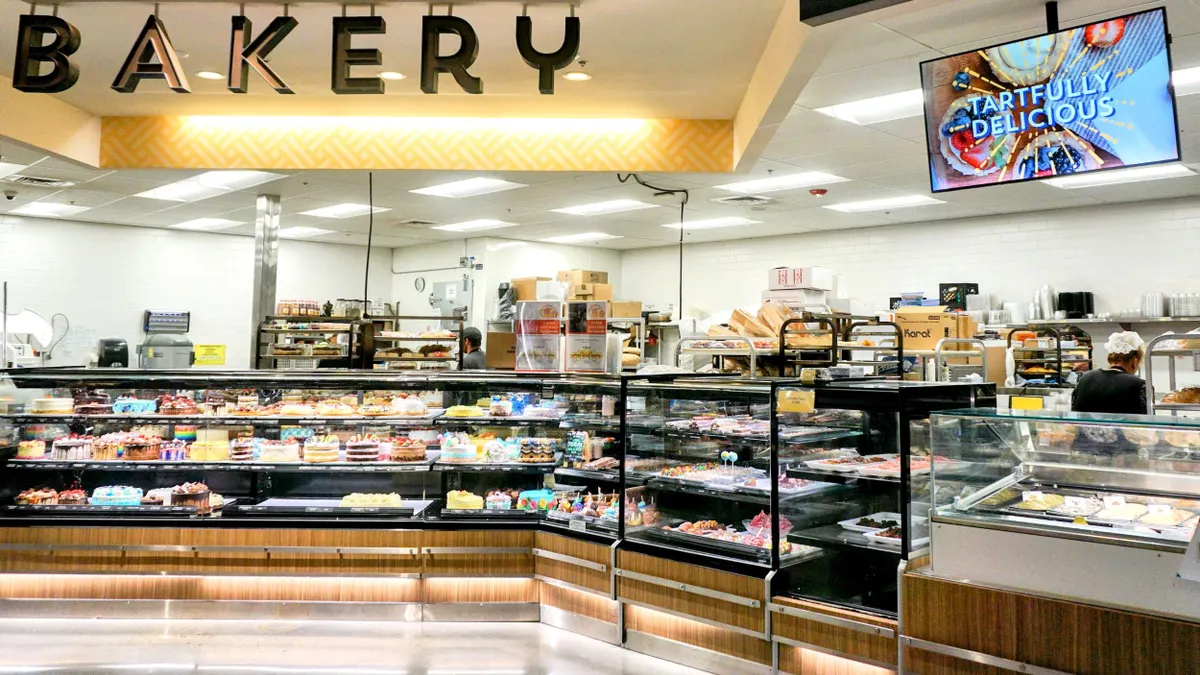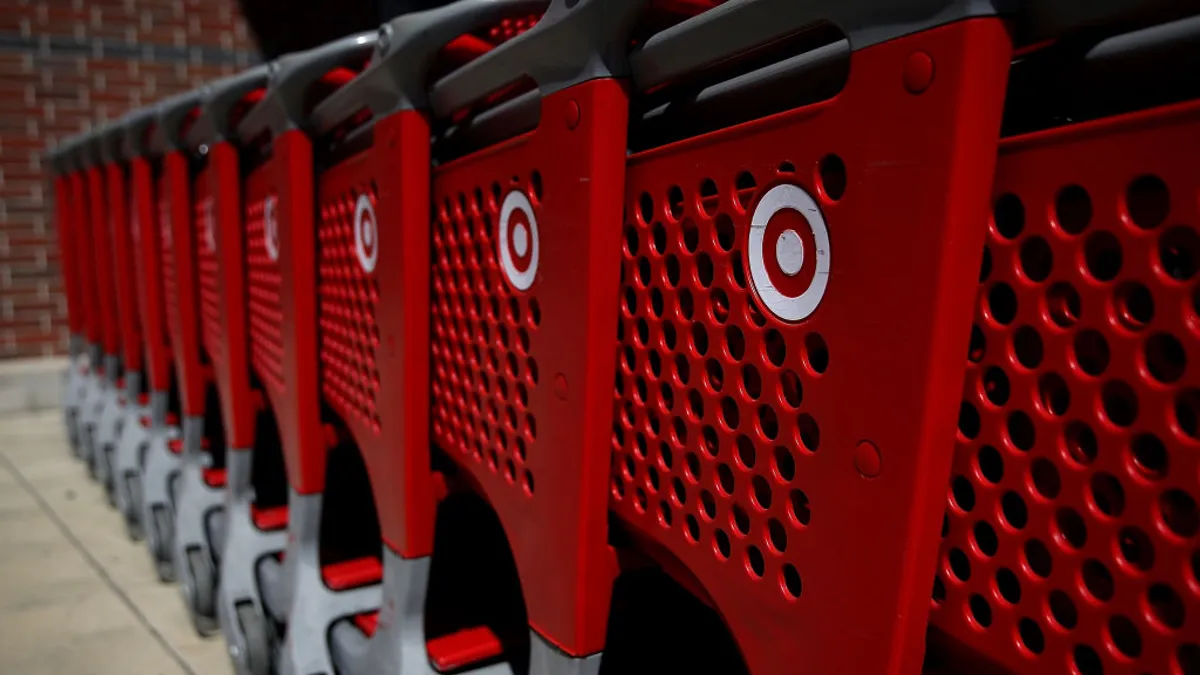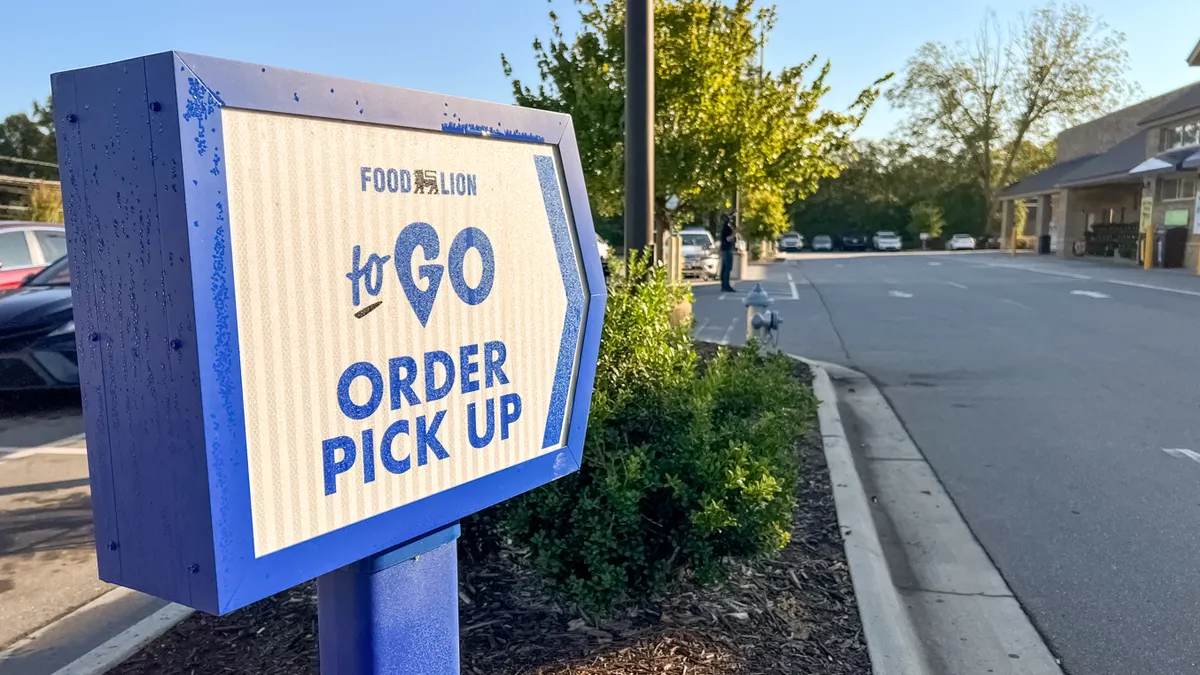As pantry-stocking consumers swarmed IGA's nearly 1,200 U.S. stores in March, CEO John Ross was on the phone daily with the company's independent grocers, keeping tabs on their struggles to navigate operating during an unprecedented pandemic.
In a scene that reverberated across the grocery store landscapes nationwide, retailers such as IGA scrambled to restock shelves, protect employees and implement other safety measures, while food manufacturers worked around the clock, refocusing their production on popular items — such as party-sized Oreos instead of single-serve packages, and best selling flavors of yogurt over more obscure ones.
“We all did great with less, so now it’s time to think about how we move forward,” Ross told Food Dive.
The pandemic's impact on the company and its product mix have the potential to reach far beyond the current environment, Ross said. If IGA and food manufacturers could succeed with fewer offerings during the coronavirus, how could they implement this strategy after it has passed in a way that optimizes product selection and ensures items are in stock while at the same time boosting sales and improving razor-thin profit margins?
"I'm not saying squash innovation because we need innovation, innovation drives sales. I'm not saying don't give shoppers choice, of course give them choice. They love choice and they want it," he said. "What I'm saying is rationalizing as a retailer and as a manufacturer is having the dialogue about how consolidating production around fewer SKUs could end up making the entire supply chain more efficient."
Ross has already been in touch with senior executives at food companies to "find out if their head is in the same space as ours" when it comes to selling fewer SKUs and still maintaining customer choice. So far, he said, "most of them are thinking right."
IGA is not alone. It's a dialogue that is taking place throughout the food industry, retailers, manufacturers and analysts told Food Dive, and it threatens to upend a landscape where over time a glut of choice has sowed confusion among consumers, snarled supply chains and heaped unnecessary costs on the industry.
Analysts who follow the food and grocery space say not only are product categories overloaded with multiple brands, product sizes, flavors or other attributes — making them ripe for a pullback to begin with — but retailers are planning to cut back on less profitable or slower-selling items in an effort to bolster their own profitability once the retail environment becomes more predictable.
In the meantime, Ross says IGA’s independently owned stores are already responding through efforts such as trimming the number of cookies made in their bakeries from dozens to the five most popular ones. The result is a streamlined approach that gets shoppers in and out faster, and frees up workers to wipe down surfaces.
Even before the coronavirus, Ross said many of IGA's stores located in places as diverse as downtown Seattle to the Appalachian Mountains in rural West Virginia were taking out aisles and compressing product assortment to make more room for fresh food, store-made items and local foods. Each IGA store contains an average of 30,000 products.
"It's inevitable that there are going to be fewer aisles and the SKUs on those aisles are going to have to be more productive," Ross said.
As retailers stocked shelves with the most in-demand and larger-sized items in an effort to increase efficiency and address consumer demands, companies such as Unilever, PepsiCo and Coca-Cola halted production of some smaller-sized packages and less popular flavors or offerings.
"I'm not saying don't give shoppers choice, of course give them choice. They love choice and they want it. What I'm saying is rationalizing as a retailer and as a manufacturer is having the dialogue about how consolidating production around fewer SKUs could end up making the entire supply chain more efficient."

John Ross
CEO, IGA
More space was allocated in stores for in-demand items like alcohol or paper towels. Non-edible items in retail outlets during the pandemic have increased 10%, according to IRI. While many of these displaced items have returned to shelves in recent weeks, not all of them have reappeared.
Retailers "all say when we come out of this at the other end, we are going to review suppliers. We are going to review the product mix," Neil Saunders, managing director with Global Data, told Food Dive. "Some of the brands that get kicked out might find it difficult to get back in."
One reason is the pandemic has altered habits in terms of what consumers buy, how often they shop and where they do it. At the same time, supermarkets are facing increased costs to protect workers and consumers, challenges to their distribution network as well as a further siphoning of business online where costs are higher.
"When you add all that up, it's a margin-crush environment, and one of the things you can do to help rebuild margins is cut down on the breadth of choice you have, focus on your sales on a few SKUs, buy those items in greater volume and try to get much greater economies of scale," Saunders said. "That leads to a lot of review and rationalization of product selection in stores."
The average number of product offerings in grocery stores declined 7.3% during the four weeks ended June 13, according to data provided by Nielsen. The drop came across a range of product categories, with frozen down 8.5%, deli slipping 7.7%, meat posting a decline of 7.1% and dairy falling 6.6%.
How low can you go?
Retailers, manufacturers and analysts said cutting product offerings across the supermarket shouldn't be done simply to lower the number of items being sold, but rather with the goal of pulling products that are not different enough or don't add incremental value for the category — for example, selling a 12, 24 and 32 count of beer, or in yogurt, having a dozen different varieties of a particular flavor. The Wall Street Journal noted during the last 45 years Lay’s has gone to 60 varieties of chips from four, and since 1984, Campbell Soup has quadrupled the types of soup it sells to about 400.
Once items are streamlined, the coveted shelf space can be stocked with new innovations that give shoppers choice and expand interest in the category, such as Chobani did more than a decade ago with Greek in yogurt, soda manufacturers did recently with smaller ounce cans or White Claw and hard seltzers brought to the beer, wine and spirits section.
While most areas across food and beverage could be poised for a reduction, many of those categories that have experienced consolidation already could be positioned for further squeezes, including meat, seafood, cereal, dairy, bread and bakery, Saunders said. Bottled water, olive oil and even some of the lower-selling bars — all categories where consumers are awash in options — also could see their ranks thinned.
The Food Marketing Institute said in 2018 the average food retailer carried 33,055 products compared to more than 14,000 in 1980. Walmart, the world's largest retailer, carries 142,000 different items at its Supercenter stores that can average 187,000 square feet, or more than three football fields in size.
For brands that control a lion's share of their category, fewer competitors on the shelf gives them an opportunity to further strengthen their dominance.
Idahoan, the maker of fresh-dried potatoes, hash browns and soups, joined other manufacturers in April when it pulled some of its newer offerings in favor of focusing on the production of top-selling items like Buttery Homestyle and Loaded Baked.
Drew Facer, the company's CEO, told Food Dive that even with a 70% share of the packaged potato category and a brand loyalty rate of 90%, Idahoan was eager to get the rest of its products back on shelves once it could reliably provide them to retailers. Nearly all of Idahoan's products representing 99% of its sales will be back by August, he said.
"If there is open shelf space, it's like a vacuum, somebody is going to want to fill it from somewhere," Facer said. "If the lag [in getting back to the shelf] has been longer than [a few months] then it would have been more difficult, but to say that we aren't concerned about that would be a misnomer."
Still, he added: "The items that have been on the shelf traditionally have earned the right to be on the shelf and so we trust that retailers will look at that."
Few categories have been as overstocked in recent years as yogurt. The average U.S. grocery store has 306 different yogurt varieties, according to brand sales and marketing agency Acosta, an increase of 4% since 2015. Chobani pegs that total closer to 425, and Peter McGuinness, the company's president, estimated roughly 75% of them don't sell. To underscore that point, McGuinness estimated there are about 14 different strawberry yogurts on shelves with the top two garnering 93% of the total volume.
"If there is open shelf space, it's like a vacuum, somebody is going to want to fill it from somewhere."

Drew Facer
CEO, Idahoan
With yogurt sales slowing in 2018 and early 2019, he said retailers cut back on displays by two to four feet. But even with an uptick in sales in the category as consumers spend more time at home and look for healthier options, the category is poised for further consolidation.
"We have to do a better job on SKU proliferation as a category," McGuinness said. "It has been rationalized over the past few years, but there is more work that needs to be done. It would benefit the entire category. It would lower [shopper] confusion. It would lower duplication and ultimately increase the velocity of what's left on the shelf."
Improving consumer fatigue
There's evidence that fewer product choices can improve sales by lowering customer fatigue and improving supply chain efficiency. Ross estimated when IGA trims assortment in a product category by 5% to 10%, it not only helps focus sales on the best-selling items, but it increases customer service scores because people can more easily find what they want.
For manufacturers, even though more product offerings likely means the needs of more customers are being met and revenue increases as a result, it can actually lead to more problems that outweigh the benefits.
Too big of an assortment requires more workers to get involved and can increase costs and complications of producing, storing, shipping and stocking the product, Xiang (Sean) Wan, an associate professor of logistics and supply chain management at Ohio State University who has researched SKU rationalization, told Food Dive. In addition, there's a point where as offerings grow, new SKUs aren't as effective in drawing people into the category — companies instead merely cannibalize existing products — and consumers just become overwhelmed.
"Many people think that the more SKUs, the more you can satisfy the customer's preference better, but too much of a product variety may not be a good thing, especially right now" with the pandemic where people are less willing to experiment, Wan said. He noted shoppers who face too broad of an assortment can become frustrated and pick the item they're familiar with or "they just walk away."
Nestlé was in the process of dropping some Lean Cuisines varieties, partly because they slowed production too much compared to their popularity, but that the coronavirus expedited that review, John Carmichael, the company's foods division president in the U.S., told The Wall Street Journal. Some of the discontinued meals may reappear and new varieties are being developed for a potential launch in 2021.
At PepsiCo, its Frito-Lay division cut about 21% of its SKUs during the peak of the coronavirus outbreak, including lightly salted Lay's potato chips and Xxtra Flamin Hot Cheetos, Mike Del Pozzo, chief customer officer at the snack's unit, told Food Dive. Frito-Lay has since resumed production of 95% of the items it temporally pulled, but Del Pozzo said it could end up trimming 3% to 5% of its pre-pandemic offerings in stores. The company is targeting those that add complexity to its distribution system or have low consumer demand.
"What I've heard consistently from [retailers] is absolutely they are potentially looking at assortment reduction driving productivity, but every one of them has said innovation will still be a key lifeblood to the category," he said. "The last thing we want to do is remove something that either is relevant to somebody today or will be tomorrow."
To increase its likelihood of success, PepsiCo has invested in analytics and studying consumer behavior. The soda and snack giant has prioritized tailoring its product mix to a drug store, convenience store or retail outlet where the type of shopper or reason for the visit changes what products the individual is looking for. If the snack isn't available in stores, PepsiCo could decide to sell it on its burgeoning e-commerce platform.
"At the end of the day, retail is what is still going to drive our business, but trying to think about different ways to make sure all the products we have are available and accessible to consumers wherever they are," Del Pozzo said.
The food and grocery landscape is littered with retailers who struggled to find the right product assortment.
A Harvard Business Review article in 2012 noted how Walmart customers said they wanted less cluttered stores, prompting the company in 2008 to remove 15% of the SKUs it carried. Sales later declined significantly, and Walmart was forced to roll back most of the changes. And Superfresh, then owned by the now defunct grocery retailer A&P, stopped carrying many of its low-selling dry grocery items in order to carry more fresh products. But the eliminated items turned out to be essential to customers and when people couldn't find them, they went shopping at a competitor.
As consumers purchase more of their groceries online, that shift will increasingly play a bigger role in what items retailers offer on store shelves. Supermarkets might find that certain offerings sell better through e-commerce channels than they do in the store.
Tom Custer, vice president with FRCH Nelson, told Grocery Dive in June that rather than cut whole categories, retailers could sell products like pet food or apparel online, or only stock the top performers in stores and then offer a wider assortment online.
“Do you really need a whole aisle of pet food when you’re already competing with pet food stores? That could be a subscription-based service or an online purchase," he said.
Another looming factor will come when the post-coronavirus world unfolds. Product mix will be dictated in part by how much time consumers spend working or entertaining from home. Some of the assortment also will undoubtedly be influenced by further investment in private label by retailers, which is expected to siphon market share away from big-name brands.
Eye on innovation
Elly Truesdell, who worked at Whole Foods overseeing local brands and product innovations before leaving in December 2017 to become a partner at Almanac Insights, said people spending less time in the office could make multi-serve or larger format items more popular. A single-serve yogurt, for example, could see its popularity wane in favor of a bigger container with multiple serving sizes.
And even before the coronavirus, there was a shift among consumers toward making fewer trips to the store — Statista estimated consumers make 1.5 weekly trips per household, down half a trip from a decade ago — but spending more when they do. The pandemic has likely expedited that habit and increased the demand for larger items. With these packages taking up more space on shelves, Truesdell said there could be added pressure on manufacturers from retailers to remove some SKUs in order to carry these bigger items.
"There has just been a necessary shift around product assortment," she said. Food manufacturers "have to really be on their game like never before to understand" what retailers want in their stores.
But Truesdell warned as manufacturers face pressure to cut back, they can't lose sight of the need to innovate. After years of watching sales slide as consumers flocked toward fresher, healthier and other more on-trend foods, CPGs have seen a dramatic swing in demand for their iconic brands like Campbell Soup and Kraft Heinz's boxed macaroni and cheese.
"There was a very quick and probably too reactive response to say 'Yup, we're doubling down on our current portfolio. We're pumping the breaks entirely on innovation,'" Truesdell said. "It would be a real oversight and a completely narrow interpretation of what innovation means for them to not continue to invest in some of that reworking of their [product] assortment."
Not all manufactures appear to have adopted that attitude. In recent weeks, there has been a barrage of new offerings announced for later this year.
Conagra Brands is rolling out Healthy Choice Bone Broth Soups and a Birds Eye Meatless Lasagna with Gardein Plant-Based Protein — one of more than two dozen new products from the food giant. Kellogg's Kashi line is adding a superfoods cereal to its Kashi by Kids brand. For Halloween, snack and confections giant Hershey is rolling out Vampire Kisses filled with strawberry creme and a Cookies 'n' Creme Fangs bar that can be munched on to reveal the creature's pointy teeth.
Krishnakumar Davey, president of strategic analytics at IRI, told Food Dive having a variety of new products to complement the shelf mainstays is crucial for manufacturers to attract new shoppers and retain long-term interest in their brands, while keeping retailer interest in carrying their products. In the current environment, he said consumers are seeking variety as their in-home consumption has increased significantly, and they are valuing foods that are healthy, extra lean and locally raised.
By providing products that better respond to shopper demands, manufacturers have a better chance of grabbing shelf space created by product disruption during the pandemic or the eventual culling of SKUs. It also increases the likelihood that they're able to retain customers who recently may have tried their products for the first time as they purchased items to stock up at home.
"You may not care about the SKU of toilet paper, maybe you're comfortable with one, but in terms of food, you are going to see variety," Davey said. "To build share, [manufacturers] have to innovate ... and it's not like we're suddenly going to shrink our supermarkets."






















